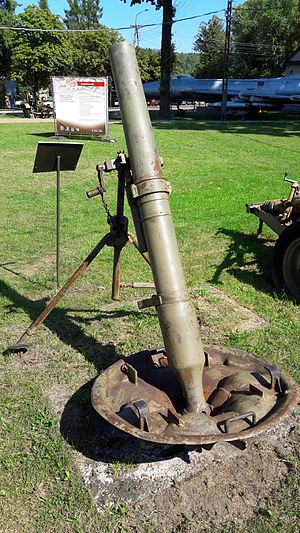| 107mm mortar M1938 | |
|---|---|
 107mm mortar M1938 in White Eagle Museum 107mm mortar M1938 in White Eagle Museum | |
| Type | Heavy mortar |
| Place of origin | Soviet Union |
| Service history | |
| In service | 1943–1975 (Soviet Union) 1938–present |
| Wars | World War II Korean War Vietnam War Laotian Civil War Lebanese Civil War Afghan Wars 2011 Libyan civil war |
| Production history | |
| Designed | 1936 |
| Specifications | |
| Mass | 170 kg (370 lb) |
| Barrel length | 1.67 m (5 ft 6 in) |
| Diameter | 107 mm |
| Crew | 5 |
| Shell | 9.1 kg (20 lb) bomb |
| Caliber | 107 mm (4.2 in) |
| Breech | muzzle loaded |
| Elevation | 45° to 80° |
| Traverse | 3° |
| Rate of fire | 15 rpm |
| Muzzle velocity | 302 m/s (990 ft/s) |
| Effective firing range | 6.3 km (3.9 mi) |
| Filling | TNT |
| Filling weight | 1.0 kg (2 lb 3 oz) (OF-841A) |
The Soviet 107mm M1938 mortar was a scaled-down version of the 120mm M1938 mortar intended for use by mountain troops and light enough to be towed by animals on a cart.
History
In World War II, the 107mm mortar saw service with Soviet mountain infantry as a divisional artillery weapon. Weapons captured by the Germans were given the designation 10.7 cm Gebirgsgranatwerfer 328(r). Its last significant use in battle was in the Vietnam War. The ability to break down the weapon made it particularly suited to the rugged terrain of Vietnam.
The mortar fired a light HE round (OF-841) and a heavy HE round (OF-841A). The lighter HE round actually carried a larger bursting charge than the heavier HE round. Both rounds used GVMZ-series point detonation fuzes.
Recently, the weapon has been seen in use by rebel forces during the 2011 Libyan civil war.
Users
 Afghanistan
Afghanistan People's Republic of China
People's Republic of China Nazi Germany
Nazi Germany Laos
Laos Kazakhstan
Kazakhstan North Korea
North Korea Russia
Russia Soviet Union
Soviet Union Vietnam
Vietnam
and many others
See also
Weapons of comparable role, performance and era
- Ordnance ML 4.2 inch Mortar - British equivalent
- M2 4.2 inch mortar - US equivalent
Notes
- Rottman, Gordon L. (December 2002). Korean War Order of Battle: United States, United Nations, and Communist Ground, Naval, and Air Forces, 1950–1953. Praeger. p. 198. ISBN 978-0-275-97835-8.
- Ian Hogg (ed.), Jane's Infantry Weapons 1984-85, p. 636, London: Jane's Publishing Company Ltd., 1984
- Steven Zaloga and Leland Ness, Red Army Handbook 1939-1945, p. 47, Phoenix Mill: Sutton, 1998
- Chamberlain, Peter (1975). Mortars and rockets. Gander, Terry. New York: Arco Pub. Co. p. 31. ISBN 0668038179. OCLC 2067459.
- skysoldier17.com
- Defense Intelligence Agency, Projectile Fragment Identification Guide, pp. 201-202, Washington: GPO, 1973
- Archived at Ghostarchive and the Wayback Machine: الثوارعلى مشارف البريقة (01) Ajdabiya 2011.07.17 .MP4. YouTube.
- Bhatia, Michael Vinai; Sedra, Mark (May 2008). Small Arms Survey (ed.). Afghanistan, Arms and Conflict: Armed Groups, Disarmament and Security in a Post-War Society. Routledge. p. 66. ISBN 978-0-415-45308-0.
- ^ Gander, Terry J. (4 June 2001). "107 mm M-38 mortar". Jane's Infantry Weapons 2002-2003. pp. 3685–3686.
- Gander, Terry J. (22 November 2000). "National inventories, Laos". Jane's Infantry Weapons 2001-2002. p. 3085.
- Small Arms Survey (2012). "Blue Skies and Dark Clouds: Kazakhstan and Small Arms". Small Arms Survey 2012: Moving Targets. Cambridge University Press. p. 131. ISBN 978-0-521-19714-4. Archived from the original (PDF) on 2018-08-31. Retrieved 2018-08-30.
External links
| Soviet mortars of World War II | |
|---|---|
| Light mortars | |
| Medium mortars | |
| Heavy mortars | |